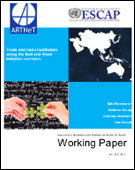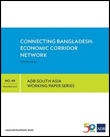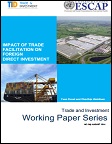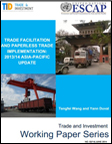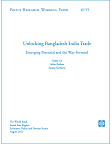Trade Facilitation Results
Trade facilitation focuses on removing barriers to the international movement of goods to lower trade costs, at and around the borders, and along the supply chain, to make countries more competitive in regional and global markets. In the SASEC subregion, bottlenecks in trade facilitation are the leading non-tariff barriers that constrain intraregional trade. SASEC initiatives in trade facilitation aims to make cross-border trade and transport in the subregion faster, cheaper, and more predictable, while maintaining the security of the supply chain and ensuring the effectiveness and efficiency of the institutions involved.
TRANSPORT BANGLADESH
WORKING PAPERS
total items: 7This paper reviews the current state of trade and trade facilitation among the countries along the six corridors under the Belt Road Initiative (BRI), and looks at the potential impact of infrastructure development on trade. It explores at the Bangladesh-China-India-Myanmar (BCIM) corridor, and reviews trade growth, tariff rates, logistics performance index, ease of trading across borders, and other indicators in those countries.
Source: Bala Ramasamy, Matthew Yeung, Chorthip Utoktham, and Yann Duval
Economic corridors anchored on transport connectivity could significantly boost Bangladesh's economic growth. This paper presents a new set of corridors for Bangladesh – a nine-corridor comprehensive integrated multimodal economic corridor network that will enhance Bangladesh’s role as land bridge between South Asia and Southeast Asia, and between South Asia and northern Asia. These proposed corridors are designed to sustain robust economic growth over the long term by improving regional connectivity, transit, and integration, alongside trade facilitation measures.
Source: Mohuiddin Alamgir
This publication provides a detailed picture of the status of specific measures for trade and transport facilitation in Bangladesh. It identifies measures already adopted, including strengthening of trade-related institutions, improvements in Customs processes and procedures, and reduction of non-trade barriers, highlighting areas for improvement and identifying existing gaps, to allow for proposals to meet these gaps. The audit undertaken aims to support policy-makers in Bangladesh in mobilizing the financial resources required to build a modern and efficient trade and transport facilitation system.
Source: Mustafizur Rahman, Khaleda Akhter and Naimul Gani Saif
This United Nations Economic and Social Commission for Asia and the Pacific Trade and Investment Working Paper attempts to quantify the potential impact of trade facilitation on foreign direct investment (FDI) flows. The study uses bilateral FDI data from 2006 onward from both developing and developed countries, including South-South FDI flows, wherein contiguity (common border between source and host country) and geographic distance are found to be much more important factors. In applying an augmented FDI model framework to determine the effect of comprehensive international trade costs, the results show that both non-tariff and tariff costs are important determinants of FDI inflows.
Source: Yann Duval and Chorthip Utoktham
This paper reports survey findings on progress in implementing various trade facilitation and paperless trade measures made by 29 countries in Asia and the Pacific, including six SASEC member countries. Factors considered include pre-arrival clearance, post-clearance audit, National Single Window, and authorized operator programmes. The survey reveals that while countries have prioritized automation and paperless trade at the regional level, there is an urgent need for regional arrangements that will facilitate cross-border exchange of trade-related electronic documents and information to enable smoother trade facilitation.
Source: Tengfei Wang and Yann Duval
This paper reports the survey findings that rice value chains are transforming in Bangladesh and India.
Source: Thomas Reardon / Bart Minten / Kevin Z. Chen / Lourdes Adriano
This working paper breaks down the importance of trade cooperation between Bangladesh and India by taking a closer look at the impacts of Bangladesh's increased market access to India, and their improved border connectivity. Employing data from national government resources and multilateral development organizations including the International Monetary Fund, World Bank, and World Trade Organization, the study provides an estimate of the trade potential of Bangladesh and India, and calculates the implications on costs of trade facilitation, among others. It also discusses ongoing challenges in bilateral relations and provides recommendations that will enable larger gains for the two contiguous countries.

